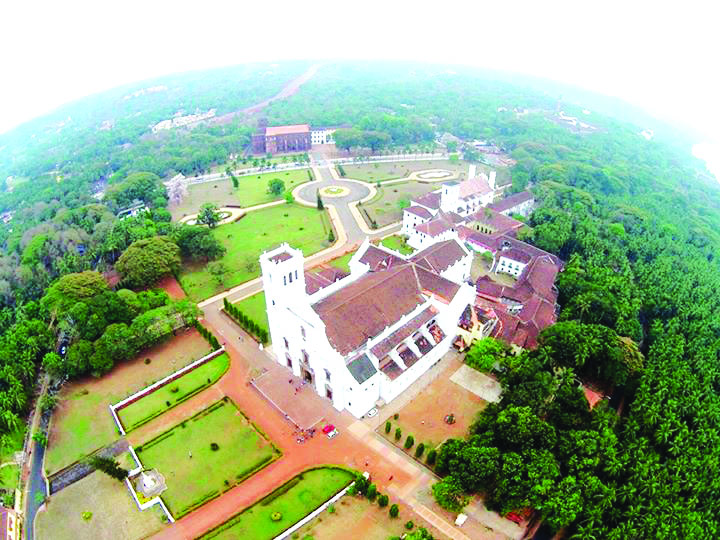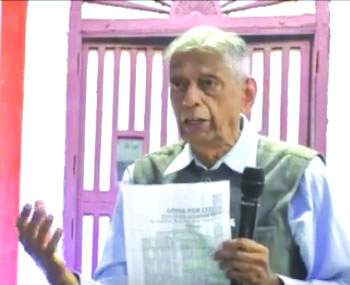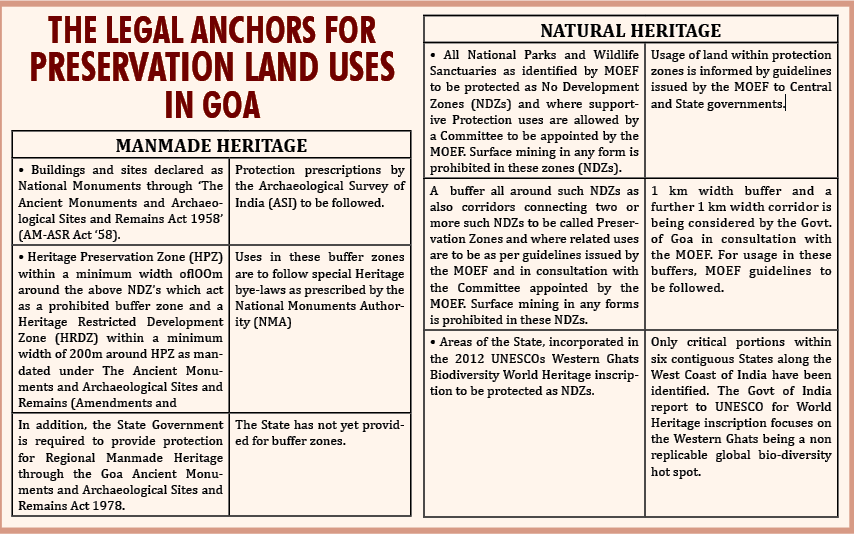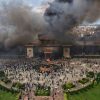Goa is abuzz with excitement as vintage bike and car owners, users, collectors and fans are decking […]

CAN PARTICIPATORY DEVELOPMENT BE INFUSED IN THE ELECTORAL WARDS OF THE HERITAGE PANCHAYAT OF SE-OLD GOA?
Feb 23- Mar 01 2019 February 23, 2019SAVE: Most enlightened countries have converted heritage areas like Old Goa with into archeological parks and gardens in toto. For example, Hampi, Borobudur, Angkor Wat, etc
By Tara Narayan
PROF EDGAR F RIBEIRO, experienced and always affectionate, also chief planner for Town & Country Planning Organisation for the Government of India for many years, keeps reiterating one thing. The people (either urban or rural citizens) are not against development and progress — as long as it is of the sustainable kind which will not shatter or worsen the quality of life they live presently. Unfortunately, governments in power in a hurry to reap quick gains today out of political compulsions can be very insensitive to the needs of the very people who vote them into power.
Goa has had excellent regional plans, including the much praised Regional Plan 2021, but here again the powers-that-be were only interested in picking and choosing selectively what suited them to implement and the rest of it was relegated to the dust bin or so to speak. Prof Edgar F Ribeiro is very positive about progress and development as long as it takes place along fundamental land use rules and regulations which are framed for the larger good and long-term interests of the land in question and the people. He was speaking to an anxious group of young citizens, architects, students of heritage conservation, at the Charles Correa Foundation located at heritage district Fontainhas, Panaji, on February 15, 2019.
On one hand he pointed out reasonably the government of Goa is keen to promote cultural and heritage tourism in places like Old Goa which is packed with architectural history and the church buildings of old recognized and listed by UNESCO. You would think the Archeological Society of India (ASI) would play a role in overseeing that no arbitrary, illegal construction activity would impact the conservation status of Old Goa — but it is not happening perhaps effectively enough. In fact, if the government is serious about promoting cultural, heritage, historical tourism, the Old Goa precinct could be upgraded as archaeology park/ historical gardens (as has been done in other countries and this was prescribed in Regional Plan 2021). Once something like this is tampered with without careful consideration, planning and consensus, there is the danger that it will be lost forever and would be impossible to recover at a later date. Once heritage is lost it is lost forever. Undoubtedly an ill-conceived highway running through Old Goa is driving all the runaway growth but this is also affecting Old Goa badly. This is how a country can lose forever its heritage and culture along with it for want of foresight and sensitivity on the subject of what conservation and preservation can do for tourism economically and socially.
Land is a static resource, pointed out Prof Edgar, and it is getting more and more scarce, it is vital that local area planning comes into the picture. Old Goa is clearly a case study of how to negate future tourism development! In contrast, thanks to the National Monuments Authority, Delhi has succeeded in implementing the law on conserving and preserving monuments and there are even 50 km buffer zones in place. In Goa there are no buffer zones, “Be aware of the law and fight through the law.”
So Prof Edgar advised the activist groups now waking up to the damage already under way as fait accompli in Old Goa, “The ASI protects and represents 3,800 such sites in India and 21 are in Goa!” His years in Delhi town planning, commented Prof Edgar Ribeiro, had taught him that it’s best to work through government links, through local authorities, the Panchayats, the residents whose quality of life is at stake in any developmental project mooted by whosoever…we have an excellent Constitution in place to rescue any project howsoever ill-conceived.
Ground realities may be frustrating, he concluded, but always keep in mind that the best development and progress is a “down to top process” and not up to down process as it is happening increasingly in Goa. It is time for Goans to do their homework at ground level and study their land maps on which many features enjoy legal protection like sacred groves and “Goa is the only state which protects hill slopes but these have been so badly damaged.”
Goans must ask their local councilors a lot of questions and brief them! As for Old Goa it is worth rescuing for history’s sake alone, for its 14 monuments of national importance (out of the 21 monuments in India) and these are legally protected – no politician, no builder, no khaas aadmi and no aam aadmi citizen can break the law. The law is always on the side of the people except that a horrible thing which is happening in Old Goa, as someone in the group present pointed out, “people themselves are putting their small agricultural plots of land together to make a larger plot and getting permission to promote gated community housing complexes! The gated community housing complex bug has bitten Goans in a big way regardless of whether it will improve or further compromise their quality of life in years to come.

PIL IN HIGH COURT
Last heard of about the public interest litigation (PIL) filed by Goa Bachao Abhiyan and Goa Foundation, the High Court has held that any action taken by parties in connection with the change of zone in the regional plan under Section 16B of the Town & Country Planning (TCP) Act, 1974, will be subject to the outcome of the PIL pending before it. It may be remembered that TCP Minister Vijay Sardesai had introduced and passed a bill in the Goa Assembly during the monsoon session last year, allowing the TCP board to make on a case to case basis any land use changes required by parties to the statutory Regional Plan of Goa 2021 on payment of fees.
However, The Goa Town & Country Plan (Amendment) Act 2018 can be notified only after the outcome of the public litigation pending before the High Court and due to come up anew on February 26, 2019. The PIL seeks direction for quashing and setting aside provisions of law (section 16B) of the TCP Act and proviso to Regulation 6.1.1(d) of the Goa Land Development & Building Construction Regulations, 2010, because it will result in ad-hoc, arbitrary conversions of privately owned plots based on individual applications. Such conversions will open the gates to rampant and unbalanced development in Goa and are not in the interests of citizens, they are also incompatible with the State’s ecological needs and violate Article 14.

THE WAY FORWARD
- With the shelf life of RPG-21 about to lapse, it is reported that RPG-31 (or RPG-35/ RPG-41) is on the anvil. It is expected that unlike RPG-21, the updated broad-brush regional umbrella for the TWO Districts of Goa would anchor the Development Plans for all the Local Authorities (Urban and Rural) of the State.
- The new regional umbrella/directional plan would be required to incorporate all the Land Uses for protection-cum-preservation and/or conservation as also those “operational uses” that drive basic growth including international and inter-state movement of commodities and people and federally restricted areas as processes through relevant instruments from the Central, Concurrent and State List.
- This inclusion in the District Plan (Regional Plan 1:25,000 scale) and their Taluka/ Development Blocks Plan (Sub-Regional Plan 1: 10,000 scale) would establish up-front, Government’s intention of “SUSTAINABLE DEVELOPMENT PLANNING” and which implies the selective provision of irreversible built space on Land- a static resource getting scarcer by the day.
- In unison, the PARTICIPATORY PLANS through Development Plans for Local Authorities (Municipalities and Panchayats) and Local Area Plans for their Wards (each with an accountable Corporator/ Councillor/ Pancha as elected by a neighbourhood-level Constituency) needs to be undertaken. At present, several Municipalities and a handful of Panchayats have ODPs on the drawing board without LAPs — the real drivers of participatory growth.
- As a case study for Rural Goa, this constitutionally savvy process is being promoted through the Se Old Goa Panchayat Development Plan and its iteratively embedded LAPs. In this Plan package, development in empathy with Heritage Preservation/Conservation is the main focus. Each of the other 189 Panchayats would have a different focus in sync with State Visions and Regional Growth directions. However, the Plan formulation format as incorporating the channelised ward-level citizen participation would be common.
- Ideal spatial documents for this exercise would comprise of 1:5000 scale maps/plans for the ODP/CDP process supported by 1:2500 scale maps/ plans for the LAP process
- Clearer the base maps, better the participation and outputs.
- For Se-Old Goa, if the following legalised land reservations through related laws of the nation are marked on the spatial plans, the citizen debates on Old Goa would not be as open-minded as at present.
a) Lands under the protection of the ASL These lands encompass monuments to be preserved by the ASI including 7 identified by UNESCO in their World Heritage List.
b) Lands round the ASI protected areas to be conserved by the NMA in empathy with the monuments. This is to be through a Plan with regulations by the NMA in consultation with the ASI and the State Government (through TCP Department).
c) 50 m belt along the bund of the River Mandovi. Uses in this area to be prescribed by the appropriate arm of the State Government.
d) All land uses as identified for protection/ conservation/ conditional development under relevant instruments of the Central/ Concurrent and even State lists. These land uses are to be finely tuned in the LA Plans through the consultancy process. - Within the core area of this Panchayat, among the owners of built space and of land, the Archdiocese of Goa and institutions under their care are prominent stakeholders. Also, the Panchayat area apart From receiving an escalating number of international and national day-time tourists also caters to seasonal short-stay and day-time pilgrims.
- The infrastructure provisions therefore required for Se-Old Goa has to be finely tuned with a floating population far in excess of the resident population for a major part of the year. There are several stakeholders in this Panchayat In the process there is only limited scope for promotional development in this Panchayat which is not related to Heritage and a floating population.
(Extracts from Prof Ribeiro’s presentation)
•














